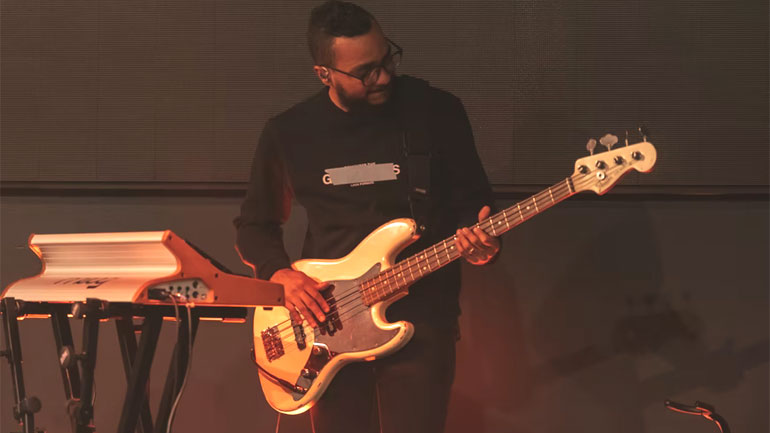
The guitar remains one of the most sought-after instruments to learn, but many beginning guitarists are unclear where to begin. Learning guitar TABs and notating techniques are valuable skills that will make starting playing the guitar much easier for beginners.
Whether you’re new or a pro who wants to go through in-depth details on guitar music, here’s a guide that can help you on the step to learning the instrument.
How Does Guitar Tablature Work?
Tablature or Tab is a sort of sheet music scoring created to assist guitarists and bassists in learning to play their favorite tunes quickly. There is two importance of TABs for guitarist:
- The fret positions are linked to the notes on the staff with the help of the Tab.
- Guitar Tab gives annotation to the style in which the notes are expressed.
The number of lines will always be the same as the number of strings on your instrument. A six-string guitar, for example, will have six horizontal lines, whereas a four-string bass will have four.
A guitar tab is a simple music notation that tells you which notes you need to play to complete the song. Most classical guitarists have used Fernando Sor notation with TABs when first learning their guitar playing.
Take note that the first string, as the thinnest guitar string, is the first line of the Tab. While the sixth string, as the thickest string, is the last line of the Tab.
6 Notating Guitar-specific Techniques
The tab format consists of six lines, each representing one of the guitar’s loose strings. The strings in the Tab are in the following order, from top to bottom. If you want to know how to read guitar TABs, here’s a rundown of the most common symbols you’ll come across:
- h = hammer-on
- p = pull-off
- / = slide up
- \ = slide down
- b = bend
- PM – – – – = palm muting
- ~~~ = vibrato
- t = tapping
- x = muted hit
- <> = natural harmonics
- () = grace note
1. Hammer-ons and Pull-offs
A slight slur or arc between two or more adjacent notes distinguishes hammer-ons from pull-offs. It may take some practice to get to the point where you can swiftly understand this, but once you’ve been exposed to a few similar musical circumstances, you’ll get the hang of it.
This method involves using the left hand to pound the string into a certain fret without using the right hand. It’s by a line linking one note or by the letter h next to the number that shows the fret to be played.
2. Slides
It’s one of the unusual symbols that you can encounter in tabs. All of these symbols denote specific guitar approaches for playing the notes.
A fret number and a line depict sliding on the guitar. The line will slant up or down if you’re sliding from a higher to a lower pitch. For example, you can go over to B string through one fret to the next, sliding the finger through the instrument’s frets until it reaches its objective.
3. Vibrato
Vibrato is an expressive voice effect achieved by continuously bending and releasing a note. If you’ve been playing guitar music since then, you’ll know how vibration affects the tune. It is by “shaking” your finger up and down as if making a lot of very quick bends.
A squiggly line is generally drawn across a note to signify this. The thickness or intensity of the squiggly line indicates how powerful or broad the vibrato should be.
4. Downstrokes and Upstrokes
Upstroke indicators resemble a downward-facing arrow, while downstroke indicators like a squared-off upside-down “U.” You’ll notice picking indicators if the composer produced a piece of music with a specific picking pattern in mind. You won’t see any indicators if they didn’t, and you’ll be free to experiment with your picking patterns.
5. Palm Mute
A “P.M.—” marker is used to indicate palm muting. The small dashes indicate how long you should palm mute the notes for. Muted notes, often known as dead notes, are shown by an “x” string. When you come across that note, mute it with your left or right hand and play it until the pitch is entirely muted.
6. Bending
In Tab, Bending is a fairly typical feature. An upward-pointing arrow adjacent to one or more numerals indicates that you should bend the note. An indicator next to the arrow will show how much you should bend the note.
Once you’ve been exposed to a few bends, you’ll soon grasp the basic concept. Play the complete one line of tab technique and see if you can pick the tune.
Wrap up
Every musician must learn sheet music because tablature does not provide information about the song’s beats and rhythms. Although there is a time notation in the guitar Tab, it is less commonly used. So, unless you are a newbie in music studies, don’t limit yourself to guitar techniques.
Additionally, reading guitar TABs teaches you to start making your music. Practice more and learn more until you are confident!




